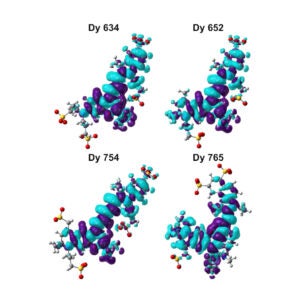Long-term Objectives

The qDNA group is working towards the long term goal of creating room temperature molecular excitonic quantum computing & quantum entanglement with the objective of Optimizing the key parameters Jm,n, Km,n, τp, τh,τd To accomplish this task our group is split into 5 research teams:
Dye Synthesis Team
The Dye Synthesis Team, led by Dr. Olya Mass, a Senior Research Scholar, develops novel dye molecules to create molecular quantum materials. These dyes are important because, without them, it would be impossible to create the desired quantum phenomena. And these are not just any dyes. They are designed to interact with light and transfer its energy in the same way that chlorophylls do in plants. “We take inspiration from photosynthesis to design our molecular systems for quantum computing,” Dr. Mass said. “The photosynthetic function is similar to how we want our quantum systems to function.”
- Organic synthesis of dyes and dye aggregates
- Optimization of dye chemical structure to enhance photophysical parameters necessary, in theory, to establish room temperature quantum computing and
entanglement at room temperature
DNA Construct Synthesis Team
Led by Associate Professor Jeunghoon Lee. The team studies how energy is transferred between molecules with as little energy loss as possible using synthetic DNA templates. Unlike in the human genome, where the combinations of the four base pairs are used to store information in DNA, qDNA uses DNA as a molecular scaffold. To study how the quantum information is being preserved and manipulated between dye molecules, Lee and his team use these four base pairs like an extremely tiny, nano-scale “Lego” set to organize the aforementioned dyes into desired frameworks, or dye aggregates.
Synthesis, steady state optical characterization, and Frenkel/Molecular Aggregate modeling of:
- Dye aggregates to examine the extent of exciton delocalization and the strength of exciton coupling, Jm,n
- Dye Structure/property relationships on aggregation and Jm,n and Km,n
- DNA template engineering
Ultrafast Spectroscopy Team
Led by Dr. Ryan Pensack (Principal Research Scholar, Graduate Faculty), Dr. Daniel Turner (Principal Research Scholar, Graduate Faculty), and Dr. Paul Davis (Surface Science Lab Manager, Graduate Faculty). Pensack, Turner, Davis and their team use light at optical frequencies to characterize DNA-assembled frameworks, including lasers pulses that irradiate the samples in pico-(one trillionth) and femto- (one quadrillionth) second bursts. Using these short bursts of laser light, the team generates superpositions of electronic transitions in the DNA-assembled aggregates and measures how frequently these superpositions oscillate and how long they last. These key results inform the broader quantum DNA research group about the interaction energy between molecules in the aggregates and how the environment interacts with the sensitive superpositions.
New research capabilities that have been built/established include:
- Two-dimensional electronic spectroscopy
- Femtosecond coherence spectroscopy
- Stark (electro) absorption spectroscopy
- Femtosecond transient absorption spectroscopy
- Femtosecond fluorescence upconversion spectroscopy
- Time-correlated single photon counting (picosecond
fluorescence spectroscopy)
For a full listing, please see the Equipment & Facilities page of the Ultrafast Laser Complex web-site.
Learn more about the Ultrafast Laser Spectroscopy Team
Single Molecule Characterization Team
- Characterize dye orientation relative to DNA origami template—key to validating control of dye positioning (and hence, Jm,n and Km,n)
- Dipolar imaging and super-resolution microscopy
- Key Parameter measurements:
- μ orientation and Jm,n on single constructs
Single Molecule Characterization Team
Theory and Simulation Team
Led by Associate Professor Lan Li and Distinguished Research Fellow Bernard Yurke, the team develops and implements theory, numerical models, computational modeling, and machine learning techniques. The team also determines dye structure-property relationships, predicts dye aggregate-DNA interactions, and designs excitonic molecular quantum gates and entangled systems.
- Frenkel/molecular aggregate model development and coding (quantum mechanical theory)
- Density Functional Theory (DFT) and Time Dependent (TD) DFT of dyes and dye aggregates
- Molecular Dynamics (MD) and hybrid Quantum Mechanics and Molecular Mechanics (QM/MM) of DNA-dye aggregates
- Machine learning – dye surveys
- Key parameters of interest: Excitonic hopping parameter Jm,n, & Exciton-exciton interaction energy Km,n,
Learn more about the Theory and Simulation Team